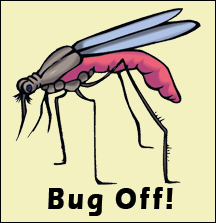Updated September 25, 2017
Several people have asked me recently about soaps and cosmetics that repel insects. What are the regulations and how do they get labeled?
Once there’s a “pesticide” claim (that is, that the product repels insects), the product falls under the jurisdiction of the EPA, under the authority of the Federal Insecticide, Fungicide and Rodenticide Act (FIFRA). The EPA are the ones that protect us from unsafe, toxic, and mis-used poisons.
Generally insecticides (quite understandably) require safety substantiation, registration, and pre-market approval. However, there are provisions for “minimum risk” pesticides (such as citronella candles, for example).
Exemption from FIFRA
The EPA doesn’t review or register minimum risk pesticides that meet certain criteria; they are exempted from registration under section 25(b) of FIFRA. The criteria for exemption are detailed on the EPA’s webpage “Minimum Risk Pesticides“.
Here’s a brief overview of the criteria. Note that ALL FIVE criteria must be met in order to qualify. Be sure to check the actual web page and read the links before finalizing your product’s formulation and labeling.
1. Approved ACTIVE Ingredients
The “active ingredient(s)” are the ingredients that are active in actually repelling the insects. The ingredients on the list of 31 active ingredients (the “25(b) list”) are the ONLY active ingredients that may be used in minimum risk pesticides. They are:
Plants, spices & essential oils:
- cedar oil
- cinnamon and cinnamon oil
- citronella and citronella oil
- cloves and clove oil
- eugenol
- garlic and garlic oil
- geraniol
- geranium oil
- lemongrass oil
- mint and mint oil
- peppermint and peppermint oil
- rosemary and rosemary oil
- spearmint and spearmint oil
- thyme and thyme oil
- white pepper
Fixed oils:
- castor oil
- corn oil
- cottonseed oil
- linseed oil
- sesame oil
- soybean oil
Other:
- citric acid
- corn gluten meal
- dried blood
- lauryl sulfate
- malic acid
- 2-Phenethyl propionate
- potassium sorbate
- putrescent whole egg solids
- sodium chloride (common salt)
- sodium lauryl sulfate
- zinc metal strips
2. Approved INERT Ingredients
The “inactive ingredients” used in a minimum risk pesticide must be included in what has been historically called “List 4A.” List 4A ingredients may be used in any amounts, although only ingredients approved for “food use” may be used for foods.
List 4A is 10 pages long and includes about 250 or so items. At the top it is also noted that commonly consumed food commodities, animal feed items, and edible fats and oils (as described in 40 CFR 180.950(a), (b) and (c)) are also acceptable as inert ingredients. “Commonly consumed food commodities” (as listed in the regulation) are foods that are commonly consumed for their nutrient properties and include:
- Sugars such as sucrose, lactose, dextrose, and fructose, and invert sugar and syrup
- Spices such as cinnamon, cloves, and red pepper
- Herbs such as basil, anise, or fenugreek
Specifically EXCLUDED from “commonly consumed food commodities” are:
- any adulterated food
- raw and processed forms of peanuts, tree nuts, milk, soybeans, eggs, fish, crustacea, and wheat
- alcoholic beverages
- dietary supplements
NOTE that “edible fats and oils” includes peanut, tree nut and soybean oils, nut oils when they are “highly refined via a solvent extraction procedure,” but specifically excludes plant oils used to impart their characteristic fragrance and/or flavoring. In other words, essential oils can’t be used as “inert ingredients.”
3. All Ingredients on the Label
The label must include all of the active and the inert ingredients. Active ingredients must be listed with the name and percentage by weight. Inert ingredients need only be listed by name.

4. No Public Health Claims
Generally, public health claims are prohibited, and minimum risk pesticides cannot link any specific disease to any claim to control pests (rodent, insect or microbial).
5. Business Name and Address on the Label
The name of the producer or company for whom the product was produced and the company’s contact information must be prominently on the product label.
6. No False or Misleading Statements
The label may not include any false or misleading statements. Claims that the product protects human or public health are prohibited. The example on the EPA website is that since these products are exempt from federal registration, no claims can be made that imply there has been any registration, review, or endorsement of the product. (Such as: “It is a violation to use this product in a manner inconsistent with the label.”)
Additional
Some, but not all, of the active ingredients require the establishment of maximum residue limits when they will be used in a way that may result in pesticide residue in food or feed.
Label Requirements
Pesticides (even minimum risk pesticides) have label requirements in addition to just putting all the ingredients on the label. The EPA’s Label Review Manual is a detailed document covering all aspects of labeling pesticides. Chapter 3, General Labeling Requirements, covers the basics.
Please note: The above is an overview of the requirements for minimal risk pesticides; it is provided to give a general feel for what is required to produce and sell a minimal risk pesticide and to give links to where you can find more information.
Before making, labeling, or selling any product that claims to repel insects (or is otherwise classed as an “insecticide” or “pesticide”) carefully review all the information on the EPA website and contact them if you have any questions.

Shameless plug!
To really be able to create your own labels that comply with the regulations, get my book from Amazon and use it.
4th Edition – Released March 5, 2025!!!
Or order directly from me (and get a signed copy)!



Leave a Reply